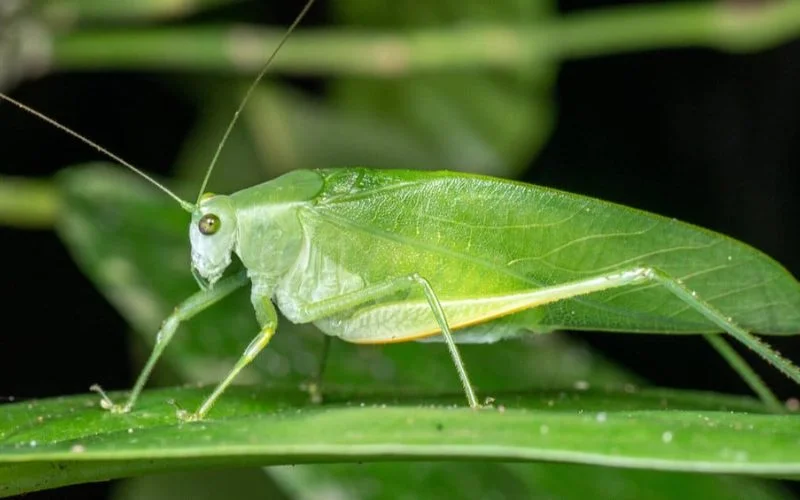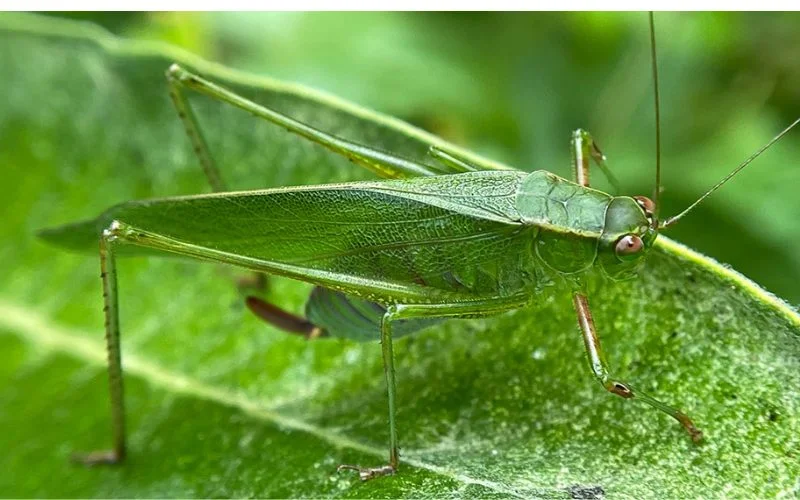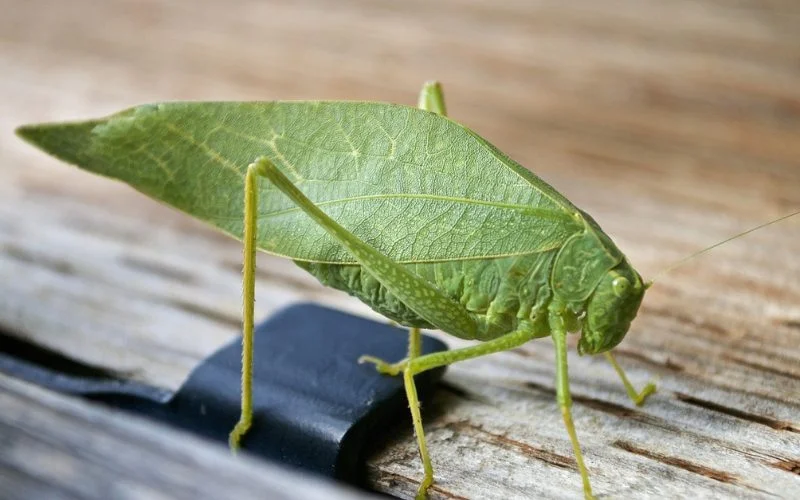If you’ve started noticing the presence of small green grasshopper-like insects in your yard or garden, you are dealing with katydids.
As implied, katydids are insects similar to grasshoppers, but their green color helps them blend well with the leaves around them, making them difficult to identify.
If you’re worried about their presence or population in your yard, you probably wonder, “are katydids harmful?” Well, katydids are not harmful to humans and do not cause severe damage to plants. Reading further, you will learn more about katydids, what attracts them, and how to eliminate them.
You may also want to check out How to Get Rid of Ants in Your Potted Plants Naturally.
What Are Katydids?

Katydids, also called long-horned grasshoppers, are insects that belong to the family of crickets and grasshoppers, and the adults grow as long as 2.5 inches.
While they are similar to grasshoppers in their vertical body shape, wings, and leg movements, you can spot the difference by observing their color and antenna length.
There are more than 6,000 types of katydids distributed globally, except in Antarctica. Two thousand species of katydids can be found in the Amazon basin rainforest, and 255 species can be found in North America.
Their love for cool and dry climates makes them more likely to be found in other regions like Australia and Africa.
Where Are Katydids Found?
Katydids can be found worldwide, but you are more likely to find them in specific places and times. Most katydids can be seen at night hunting for food, and if you have plants in your surrounding area, it is the best spot.
Some places to search include trees (especially fruit trees), shrubs, leaves, stems, fruit, and leaves.
How To Identify Katydids
With over 6000 species of this insect, it can be difficult to tell if you are dealing with katydids or an entirely different insect, especially since these types have different appearances. This knowledge is essential to help you determine your course of action and the severity of your situation.
To identify katydids, you must remember that they belong to the family of grasshoppers and cricket, so you should watch out for some similarities. Here are some ways you can successfully identify katydids.
- An antenna that is long and thin. The antenna is usually longer than the body.
- Tiny or long and broad wings
- Brown or green color mostly for camouflage
- The body length of about 0.5-2.5 inches
- Some species may have long back legs.
- You can identify the egg that is usually laid on the soil or parts of plants. These eggs are usually gray or dark brown.
- The males rapidly rub their winds together to attract females for mating. This movement usually sounds like ka-ty-did, which is where their name was derived from.
Are Katydids Harmful To Humans?

Katydids are not harmful to humans, so if you are worried about their potential damage when you see them around, you can have peace of mind.
While they are not toxic, they can bite you when threatened. However, their bite is not very painful as it has been estimated to be just like a mosquito bite.
If you ever get bitten by a katydid, do not panic. Instead, it would be best to wash the affected area with soap and water; in case of pain and swelling, you can use a cold compress to reduce the effects. It is scarce for katydid bites to need medical attention.
Are Katydids Harmful To Plants?
Katydids feed on leaves and other plant products so that you may observe holes in your plant’s leaves. However, no severe damage is caused to the plants.
A specific katydid species tends to feed on the foliage of plants which can be a problem. These species have broad wings which are veined.
In some cases, this insect can damage fruits as they occasionally feed on them. Here are some fruits that katydids fancy the most.
- Pomegranate
- Nectarines
- Plums
- Oranges and other citrus species
- Apricots
- Blueberries
- Pears
- Peaches
They feed on a little portion of your fruit when it’s still unripe and small. However, when the fruits ripen, their marks deepen and become more prevalent. Feeding on fruits causes scarring, which does not affect the fruit’s flesh or render it inedible.
You should expect to see katydids around if you have some of these plants in your yard.
- Acacia
- Angophora
- Flax lilies
- Alpinia
- Bursaria
- Eucalyptus
How To Get Rid Of Katydids
If you have noticed a growing population of these insects in your yard or are uncomfortable with their effects on your plant, you can get rid of them. Here are some simple ways you can achieve this task.
- Using a spinosad-based pesticide: Spinosad is a mixture of Spinosyn A and Spinosyn D, which is very toxic to pests. It can also be used to control katydids. Pesticides containing this chemical alter the nervous system of insects that eat or touch it. It then causes paralysis, leading to the insect’s death. When using these pesticides, one thing to watch out for is to consider the damage they may cause to the plants in the surrounding area. You can minimize possible damage by focusing on the plants most affected by the katydids. You should also conduct some research to discover how spinosads affect the plants in your yard. If you are uncomfortable with this solution, try one of our recommended alternatives.
- Katydids repellent plants: Katydids will naturally stay away from certain plants because of their smell and body reaction to them. Here are some plants you can have around your outdoor space to prevent these insects from showing up. These plants include lavender, garlic, cilantro, mint, marigold, and chrysanthemum.
- Cut down long grasses: Katydids are big fans of an environment where they can hide and feast, making it even better since they are green. To solve this problem, trim your shrubs, mow your lawn, and dismantle the hiding spot of this insect.
- Using a butterfly net: If you are looking for a more fun and harmless solution, you can catch these insects with a butterfly net and relocate them to an environment they’ll love. This solution is excellent if there are few katydids in your yard.
- Katydids predators: If the population of katydids in your yard is growing out of hand, you can attract the natural predators of this insect to take care of the problem. It is an excellent biological solution. Some natural predators of this insect include butterflies, birds, wasps, praying mantis, and spiders. Other insects can feed on the eggs of katydids to prevent them from multiplying in your space.
- Light traps: Like some insects, katydids are attracted to bright lights for warmth. You can pair this light with a glue board to trap these insects as they lurk around the light.
- Homemade solution: you can whip up a homemade solution for getting rid of katydids using tabasco sauce, dish soap, garlic, and water. The mixture uses two tablespoons of hot sauce, 4 cups of water, four drops of dish soap, and a clove of garlic. Spray this mixture on the area where katydids primarily reside.
Facts About Katydids
This section contains some interesting facts about katydids. These facts can also help you identify these insects quickly.
- The mating sound made by male katydids can go on for hours
- Smaller species live in dry environments, which makes them have low nutritional needs.
- Smaller katydids have higher agility and rapid development
- Female katydids lay their eggs in rows
- The nymphs look nothing like adult katydids. Instead, they are similar to ants, spiders, and assassin bugs.
- They are capable of jumping 20 times their body length
- Katydids don’t usually fly. They may flutter down, but then they climb back up.
Conclusion
If there is a growing population of katydids in your yard, you may be worried about the possible dangers to your household and plants.
You should know that these insects are not harmful to humans, and in cases where they bite, they can be quickly taken care of using soap and water. You may also want to check out What to Do with Deer Poop in the Yard?
Helpful Link:
- Best Tetherball Set for Dogs
- Are Crab Apples Poisonous To Dogs
- How to Fix a Muddy Backyard Dog Trail
- Can I Shoot a Possum in My Backyard
- Can You Eat Squirrel From Your Backyard
As for your plants, no severe damage is done either. Since katydids feed on plant and plant products, you may notice some scars on fruits and some holes on leaves.
If you grow uncomfortable with these insects, you can eliminate them using pesticides, a homemade solution, some biological process, and other effective methods discussed in this article. Learning how to correctly identify katydids, what attracts them, and some fun facts about them would be best.
Kindly reach out to people by sharing this post on social media.
If you liked this article, then please follow us on Facebook, Instagram, and Pinterest.


